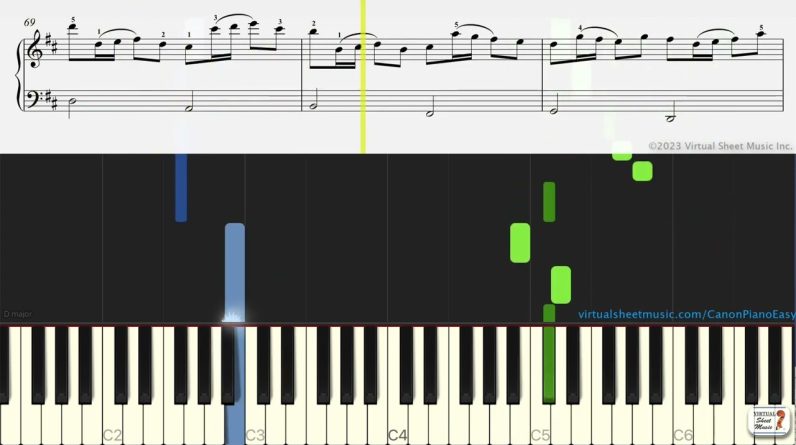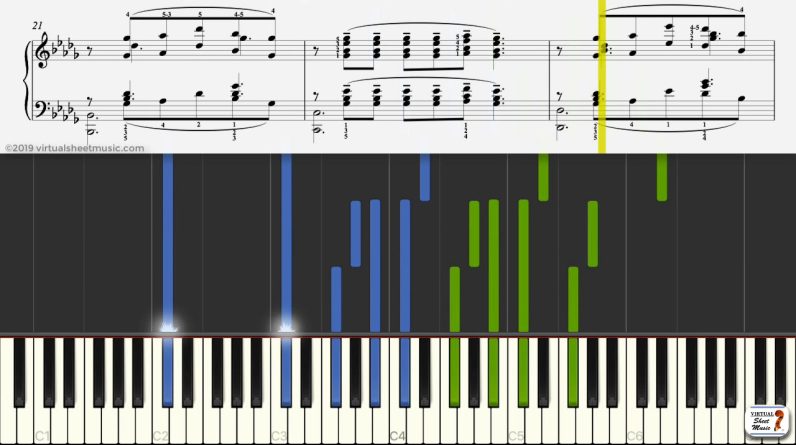This is the easiest way to learn the Moonlight Sonata by Ludwig van Beethoven and at the same time learn to read music.
You can practice with this very same video on Virtual Sheet Music® by using their exclusive interactive player which allows you to slow-down or speed-up the music, set up loops, and more.
It’s the perfect tool to practice and learn to read music at the same time!
You will find the high quality sheet music, audio Mp3, MIDI files and interactive sheet music here:
Ludwig van Beethoven: Sonata Op.27 No.2 “Moonlight” for piano solo
User Rating: ![]() (based on 68 user reviews)
(based on 68 user reviews)
“This is the “real” Moonlight Sonata- no shortcuts! Excellent quality sheet music, plus you get the mp3’s and other files so you can hear how it’s supposed to sound. Very good return for a small investment. No complaints…”
Beethoven’s Masterpiece “Moonlight Sonata”
Imagine yourself sitting in a dimly lit concert hall, surrounded by anticipation and silence. The pianist enters the stage, and the room fills with hushed whispers of excitement. As the first notes of Moonlight Sonata begin to drift through the air, you are instantly captivated.
Ludwig Van Beethoven’s masterpiece, officially known as Sonata quasi una fantasia, holds you in its enchanting embrace. Written during the Classical era in 1801-1802, this 14th piano sonata is a work of art that transcends time. Its first movement, the Adagio Sostenuto, takes you on a slow, dreamy journey, while the second movement, Allegretto, provides a calm contrast.
The final movement, Presto Agitato, demands technical brilliance from the pianist and leaves a lasting impression. With its connection to Beethoven’s deafness and the evocative imagery of moonlight, it’s no wonder that the Moonlight Sonata continues to mesmerize audiences worldwide.
Overview of Moonlight Sonata
During the summer of 1801 when this piece was composed, Beethoven was deeply in love with his 17-year-old student, Countess Giulietta Guicciardi. The Moonlight Sonata was eventually dedicated to her, although it was originally intended for another patron. However, due to her parents’ disapproval, Beethoven and Giulietta could never be together.
Introduction to Moonlight Sonata
Moonlight Sonata, officially known as Sonata quasi una fantasia, is one of Ludwig Van Beethoven’s most famous and beloved piano compositions. Composed during the Classical music era in 1801-1802, it is Beethoven’s 14th piano sonata and has captured the hearts and minds of listeners for generations.
Historical context of Beethoven and the Moonlight Sonata
To understand the significance of the Moonlight Sonata, it is essential to delve into the historical context of Beethoven’s life. Beethoven was a German composer and pianist who lived from 1770 to 1827. He was a central figure in the transition from the Classical to the Romantic period in music.
During the time Beethoven composed the Moonlight Sonata, he was grappling with his increasing hearing loss, which would eventually lead to complete deafness. This personal struggle undoubtedly influenced his compositions, including the Moonlight Sonata.
Publication and composition details
Beethoven completed the Moonlight Sonata in 1802, and it was published in Vienna the following year. The title “Moonlight Sonata” was not given by Beethoven himself but was adopted after his death in 1827.
The composition is divided into three distinct movements, each offering a unique musical experience. Let us explore each movement in more detail.
Description of the three movements
The Moonlight Sonata consists of three movements:
- The First Movement: Adagio Sostenuto
The opening movement, Adagio Sostenuto, is known for its slow and contemplative nature. It is often described as dreamy, meditative, and hypnotic. The movement begins with a serene and delicate melody, played in the lower register of the piano. The shifting harmonies create a sense of longing and introspection, captivating the listener from the very first notes.
- The Second Movement: Allegretto
Contrasting with the first movement, the Allegretto is vibrant and in a calm D-flat major key. The serene atmosphere continues, but with a more playful and lively character. This movement provides a sense of relief and tranquility, allowing the listener to momentarily escape into a world of serenity and beauty.
- The Third Movement: Presto Agitato
The final movement, Presto Agitato, is the most technically demanding and emotionally intense of the three. It displays Beethoven’s virtuosity as a pianist and his ability to convey raw emotion through music. The movement is characterized by its fast tempo, rhythmic complexity, and intense energy, creating a sense of urgency and dramatic tension that sustains until the very last note.
The First Movement: Adagio Sostenuto
Characteristics of the first movement
The Adagio Sostenuto, often referred to simply as the “Moonlight Sonata” by many, is an exquisite piece with distinct characteristics that make it stand out. It showcases Beethoven’s ability to create a mesmerizing atmosphere through his use of tempo, dynamics, and expressive phrasing.
Tempo and mood
The first movement is characterized by a slow tempo, as indicated by the Adagio marking. This deliberate choice allows the music to unfold gradually, immersing the listener in its ethereal beauty. The long, sustained notes and gentle melodic lines contribute to the dreamy and introspective mood of the piece.
Musical structure and themes
The structure of the Adagio Sostenuto follows the traditional sonata form, consisting of an exposition, development, and recapitulation. The movement opens with a hauntingly beautiful melody played in the low register of the piano, creating a sense of intimacy and melancholy. The melody is then developed and expanded upon, weaving in and out of various harmonic progressions.
Analysis of the Adagio Sostenuto
The Adagio Sostenuto is a masterful display of Beethoven’s musical genius. It showcases his ability to evoke profound emotions through simplicity, with the delicate interplay of melody and harmony. The movement’s ethereal and introspective nature has made it a timeless favorite among pianists and music enthusiasts alike.
The Second Movement: Allegretto
Contrast with the first movement
The second movement of the Moonlight Sonata, Allegretto, provides a stark contrast to the slow and contemplative nature of the Adagio Sostenuto. It introduces a new atmosphere of calm, evoking a sense of serenity and tranquility.
Key and mood
In contrast to the first movement’s C-sharp minor key, the Allegretto is in D-flat major, offering a more tonally stable and pleasant tonality. This change in key contributes to the overall calm and peaceful mood of the movement, instilling a sense of relaxation and relief.
Melodic and harmonic features
The Allegretto showcases beautiful and melodic themes, which are complemented by subtle harmonic progressions. The melody is characterized by gentle and flowing arpeggios, creating a sense of serenity and grace. Beethoven’s choice of harmonies adds depth and color to the movement, further enhancing its soothing nature.
Interpretation and analysis of the Allegretto
The Allegretto offers a moment of respite amidst the emotional intensity of the Moonlight Sonata. Its graceful melodies and harmonies create a sense of tranquility and peace, allowing the listener to momentarily escape into a world of serenity and beauty. It serves as a contrasting interlude, preparing the listener for the explosive finale of the sonata.
The Third Movement: Presto Agitato
Technical demands and significance
The third and final movement of the Moonlight Sonata, Presto Agitato, is a tour de force that showcases Beethoven’s technical prowess as a pianist. This movement demands virtuosity, precision, and a deep understanding of the rhythmic complexities present throughout.
Tempo, rhythm, and intensity
The title “Presto Agitato” sets the tone for the movement, indicating a fast tempo and an agitated character. The relentless and driving rhythms of the movement create a sense of urgency and intensity, propelling the music forward with unyielding energy. Beethoven’s use of syncopation and complex rhythmic patterns adds to the movement’s sense of restlessness and emotional turmoil.
Structural elements and musical motifs
The Presto Agitato follows a modified sonata form, with distinct musical motifs that recur throughout the movement. Beethoven’s use of recurring rhythmic patterns, melodic fragments, and abrupt dynamic contrasts creates a sense of unity and coherence. The movement builds upon these motifs, driving the listener towards a climactic and exhilarating conclusion.
Exploring the Presto Agitato in depth
The Presto Agitato is a testament to Beethoven’s ability to convey raw emotion and intensity through music. Its technical challenges and unrelenting energy make it a thrilling experience for both performers and listeners. The movement’s dramatic nature and virtuosic demands further emphasize Beethoven’s revolutionary and groundbreaking approach to composition.
Ludwig Rellstab and the Moonlight Sonata
Introduction to Ludwig Rellstab
Ludwig Rellstab, a German music critic and poet, played a significant role in shaping the perception and popularity of the Moonlight Sonata. Born in 1799, Rellstab became one of the most influential critics of his time.
Rellstab’s description of the opening movements
In 1832, Rellstab was deeply moved by the opening movements of the Moonlight Sonata. He wrote a review for the Berlin newspaper “Irische Harfe” in which he compared the music to moonlight shimmering on Lake Lucerne.
Rellstab’s poetic and evocative description captivated the public’s imagination, forever associating the Moonlight Sonata with the serene and ethereal beauty of moonlit nights.
Impact of Rellstab’s review on the sonata’s popularity
Rellstab’s review had a profound impact on the Moonlight Sonata’s popularity. His captivating imagery and emotional descriptions resonated with audiences, leading to renewed interest and widespread recognition for Beethoven’s composition.
The association with moonlight and the enchanting imagery evoked by Rellstab’s review brought the sonata into the public consciousness, securing its place as one of Beethoven’s most beloved works.
Legacy of Rellstab’s moonlight imagery
Rellstab’s moonlight imagery has endured over the centuries, becoming synonymous with the Moonlight Sonata. The public’s fascination with the serene and evocative qualities of moonlight has contributed to the enduring appeal of the composition.
The connection between the Moonlight Sonata and moonlight imagery has transcended time, with listeners continuing to be captivated by the ethereal and mystical atmosphere created by Beethoven’s music.
The Origins of the Nickname
Background on the nickname ‘Moonlight Sonata’
The nickname ‘Moonlight Sonata’ was not given by Beethoven himself but was adopted after his death. The origins of this nickname can be traced back to Ludwig Rellstab’s poetic description of the opening movements of the sonata as resembling moonlight on Lake Lucerne.
When and how the nickname was adopted
After Rellstab’s review in 1832, the reference to moonlight began to stick, and the public embraced it as a fitting title for the composition. Over time, the nickname became widely accepted, ultimately overshadowing the official title of Sonata quasi una fantasia.
Reception and recognition of the nickname
The nickname ‘Moonlight Sonata’ has garnered widespread recognition and has become the primary way in which the composition is referred to today. It has become a symbol of the sonata’s evocative power and serves as a gateway for listeners to explore its emotional depths.
The enduring popularity of the nickname is a testament to the timeless and universal appeal of the Moonlight Sonata, which continues to captivate audiences with its transcendent beauty.
The enduring appeal and symbolism of the nickname
The nickname ‘Moonlight Sonata’ has transcended its initial association with the opening movements of the composition. It has become a symbol of the sonata’s romantic, introspective, and otherworldly qualities. The imagery of moonlight serves as a metaphor for the emotional depth and evocative power of the music.
The enduring appeal of the nickname lies in its ability to evoke a sense of wonder, beauty, and serenity, encapsulating the essence of the Moonlight Sonata.
Unique Composition Style of the Moonlight Sonata
Exploring Beethoven’s innovative approach
The Moonlight Sonata is a prime example of Beethoven’s groundbreaking and innovative approach to composition. Beethoven pushed the boundaries of traditional Classical music, introducing daring harmonic progressions, expanded forms, and emotional intensity.
Expression of emotions and themes
Beethoven’s unique composition style allowed him to express a wide range of emotions and themes throughout the Moonlight Sonata. From introspective and contemplative moments to explosive and dramatic passages, the sonata serves as a musical exploration of the human experience.
Influence of the sonata on future compositions
The Moonlight Sonata has had a profound influence on future composers and musicians. Its evocative power, emotional depth, and innovative approach to composition paved the way for the Romantic period of music, which celebrated individual expression and emotional intensity. Beethoven’s compositional techniques continue to inspire and influence musicians to this day.
Critics’ analysis of Beethoven’s style
Critics have analyzed Beethoven’s unique composition style extensively. His use of unconventional harmonies, rhythmic complexities, and dramatic contrasts challenged the traditions of the Classical era and laid the groundwork for the musical innovations of the Romantic period. Beethoven’s ability to infuse his compositions with profound emotional depth has cemented his status as one of the greatest composers in history.
Association with Beethoven’s Deafness
Beethoven’s hearing impairment and its impact
Beethoven’s gradual hearing loss profoundly impacted his life and artistic career. By the time he composed the Moonlight Sonata, he was completely deaf, relying on his memories of sound to create and enhance his musical compositions.
Interpretations of the Moonlight Sonata in relation to deafness
Scholars and musicians have interpreted the Moonlight Sonata as a reflection of Beethoven’s personal struggle with deafness. The sonata’s emotional intensity, introspective nature, and dramatic contrasts have been seen as manifestations of Beethoven’s inner turmoil and his determination to overcome adversity through the power of music.
Connection between Beethoven’s personal struggles and the sonata
The Moonlight Sonata, particularly the intense third movement, has been viewed as a musical embodiment of Beethoven’s personal struggles and triumphs. It serves as a poignant reminder of the indomitable spirit and resilience of the human condition, even in the face of immense challenges.
Societal perspectives on Beethoven’s deafness
Beethoven’s deafness deeply impacted societal perceptions and attitudes towards him during his lifetime. Despite his hearing impairment, he continued to create groundbreaking compositions, proving that true artistry transcends physical limitations. Beethoven’s perseverance in the face of adversity has inspired countless individuals and serves as a testament to the power of the human spirit.
Evocative Imagery and Symbolism
Analyzing the evocative power of the Moonlight Sonata
The Moonlight Sonata’s evocative power lies in its ability to transport listeners to a realm of emotion and contemplation. Beethoven’s use of harmony, dynamics, and expressive phrasing creates a vivid sonic landscape that resonates deeply with the human experience.
Interpretations of the sonata’s imagery
The Moonlight Sonata’s imagery has been interpreted in various ways, with listeners finding their own personal connections and meanings within the music. Some envision moonlit nights, gentle waves, and serene landscapes, while others find solace, introspection, and even catharsis in its haunting melodies.
Emotional response and listener experiences
Listeners often describe experiencing a wide range of emotions when listening to the Moonlight Sonata. From deep introspection to a sense of tranquility, the music elicits a profound emotional response. The sonata is a testament to the power of music to move, uplift, and transport the listener to realms beyond the physical.
Cultural and historical symbolism associated with the sonata
The Moonlight Sonata has become a cultural and historical symbol, representing the beauty and power of human expression through art. Its timeless quality and universal appeal make it a cherished piece of musical heritage, transcending cultural and geographic boundaries.
Conclusion
Summary of the Moonlight Sonata’s significance
The Moonlight Sonata, Ludwig Van Beethoven’s 14th piano sonata, is a masterpiece that has captivated audiences since its composition in 1802. Its three distinct movements, Adagio Sostenuto, Allegretto, and Presto Agitato, offer a journey through contemplation, serenity, and emotional intensity.
Appreciation and enduring popularity
The Moonlight Sonata’s enduring popularity can be attributed to its unique composition style, which pushed the boundaries of traditional music, and its ability to evoke profound emotions and imagery. Listeners of all generations continue to appreciate and connect with the sonata’s timeless beauty.
Reflection on Beethoven’s mastery
The Moonlight Sonata stands as a testament to Beethoven’s mastery as a composer and pianist. Through his innovative approaches to harmony, form, and emotional expression, Beethoven created a work of art that continues to resonate deeply with audiences worldwide.
Final thoughts on the Moonlight Sonata
The Moonlight Sonata holds a special place in the hearts of music lovers around the world. Its enduring appeal, association with Beethoven’s deafness, evocative imagery, and unique composition style have solidified its position as one of the most beloved and significant musical compositions of all time. It is a true testament to the power of art to touch the human soul and transcend the boundaries of time.
- Canon in D by Pachelbel | Simplified for Piano Solo | Practice Video - June 22, 2025
- Pianoforall Free Sample Lesson - March 23, 2025
- Learn Moonlight Sonata Sheet Music by Beethoven, 1st Movement - March 22, 2025
Contents
- 1 Beethoven’s Masterpiece “Moonlight Sonata”
- 2 Overview of Moonlight Sonata
- 3 The First Movement: Adagio Sostenuto
- 4 The Second Movement: Allegretto
- 5 The Third Movement: Presto Agitato
- 6 Ludwig Rellstab and the Moonlight Sonata
- 7 The Origins of the Nickname
- 8 Unique Composition Style of the Moonlight Sonata
- 9 Association with Beethoven’s Deafness
- 10 Evocative Imagery and Symbolism
- 11 Conclusion







